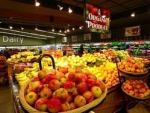 I went into our loaded-to-the-gills super market yesterday to buy a battery and was flooded with memories of just 4 weeks ago when I would walk in the door once a week after my improv class, grab a basket and make a quick light-hearted (not light fingered) swing through the sale aisle, the produce, the dairy, the meat (do you know the supermarket trick – for the sake of your pocketbook and much more, shop the perimeter, not the packaged food). I was feeding my eyes. Feeding my inner girl. Feeding my anticipation of future food. Feeding my freedom to have what I truly want. Feeding my pantry with sale foods to store. I had a twang of grief that I could do none of that two nights ago.
I went into our loaded-to-the-gills super market yesterday to buy a battery and was flooded with memories of just 4 weeks ago when I would walk in the door once a week after my improv class, grab a basket and make a quick light-hearted (not light fingered) swing through the sale aisle, the produce, the dairy, the meat (do you know the supermarket trick – for the sake of your pocketbook and much more, shop the perimeter, not the packaged food). I was feeding my eyes. Feeding my inner girl. Feeding my anticipation of future food. Feeding my freedom to have what I truly want. Feeding my pantry with sale foods to store. I had a twang of grief that I could do none of that two nights ago. 
Since I am heading into the home stretch, though, I bought a couple of bulk “health” foods that I am out of and are prior staple: oat bran and flax seeds. Now I can appreciate to a small degree what went into that bin of oat bran. Not the details but the privilege of having these little flakes readily available here on Whidbey Island. I have no idea where they began their life. The long chain of exchanges that brought them to my plastic baggie labeled with a product number.
In 2000, the rank of states in order of production was Minnesota, North Dakota, Wisconsin, South Dakota, and Iowa. Iowa acreage peaked at about 6.4 million acres in 1950 and slumped to 270,000 acres, of which only 180,000 acres were harvested, by 2000. The more profitable crop, soybean, has replaced the oat acreage.
The flax seeds, too, were now a great origin mystery. I recalled the foot rice threshers in Northern Thailand, the days of pounding it took to bring rice to their tables. Surely these seeds, no chaff, perfectly silky, were harvested by machine, not by hand. Surely they were “threshed” by something other than an egg beater and winnowed by something other than a hair dryer, but what? So I looked it up.
There’s a chance those seeds came from North Dakota, Montana or possible South Dakota or Northern Michigan. That, of course, it’s a valued crop for not only seeds but the weaving (flax fabric). That the seeds share two destinies: food or Linseed Oil which is used in the production of linoleum. (Is that what people mean about eating off the floor. Could it be eating the floor. I prefer not to imagine that when grinding the seeds to put on my salad). So I have a little better idea who to thank. And how hard they work to grow my food.
Just that purchase opened a little window into how I might be in relationship with my food system – joyfully and responsibly – after next Friday.
Annie Leonard traveled for years giving a lecture with little cut outs of people and factories to explain the whole system that turns planet into products into trash. Finally she made the 8 minute Story of Stuff, which has now been viewed by millions of people worldwide.
I’m beginning to see that I am diving in to a story of food, knowing that awareness itself transforms our relationship with whatever substance flows through our lives – money, stuff, food, time and more. My 10 mile diet has given me an almost microscopic view of my food system, allowed me to see what it takes and who it takes to feed me. It’s made me humble, grateful and given me almost microscopic vision as I walk around the Goose and contemplate the thousands of products, each with their own story and their own connection to the great chain of being.
How can I not be grateful to this global food system? To treat it like it’s toxic and unjust (even when it is) would at least upset my stomach as well as being unfair to the millions of people who put food on their own tables by putting food on mine. That’s why I like to curious and conscious, rather than simply right and righteous. I’m not into black and white thinking. I’m not into even shades of gray. I’m into the technicolor unto day-glow intricate web of things and relationships that make up our world and tasting every morsel of it with gratitude.
Carolyn Steel, author of Hungry City, does a better job than I in revealing the complexity of feeding us all – living as we do. We qualify as her city of the future called Sitopia – food place.
http://www.ted.com/talks/lang/eng/carolyn_steel_how_food_shapes_our_cities.html
